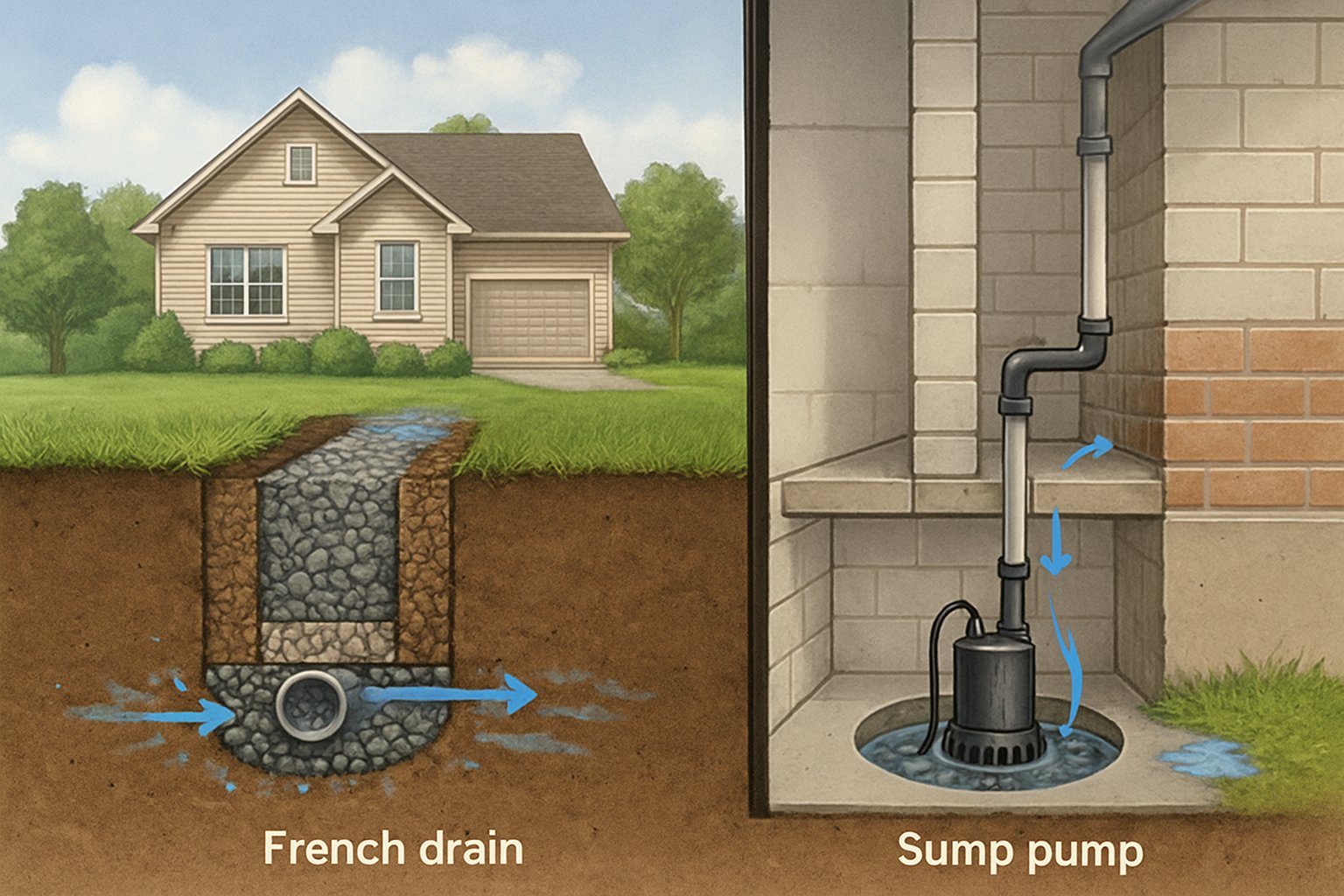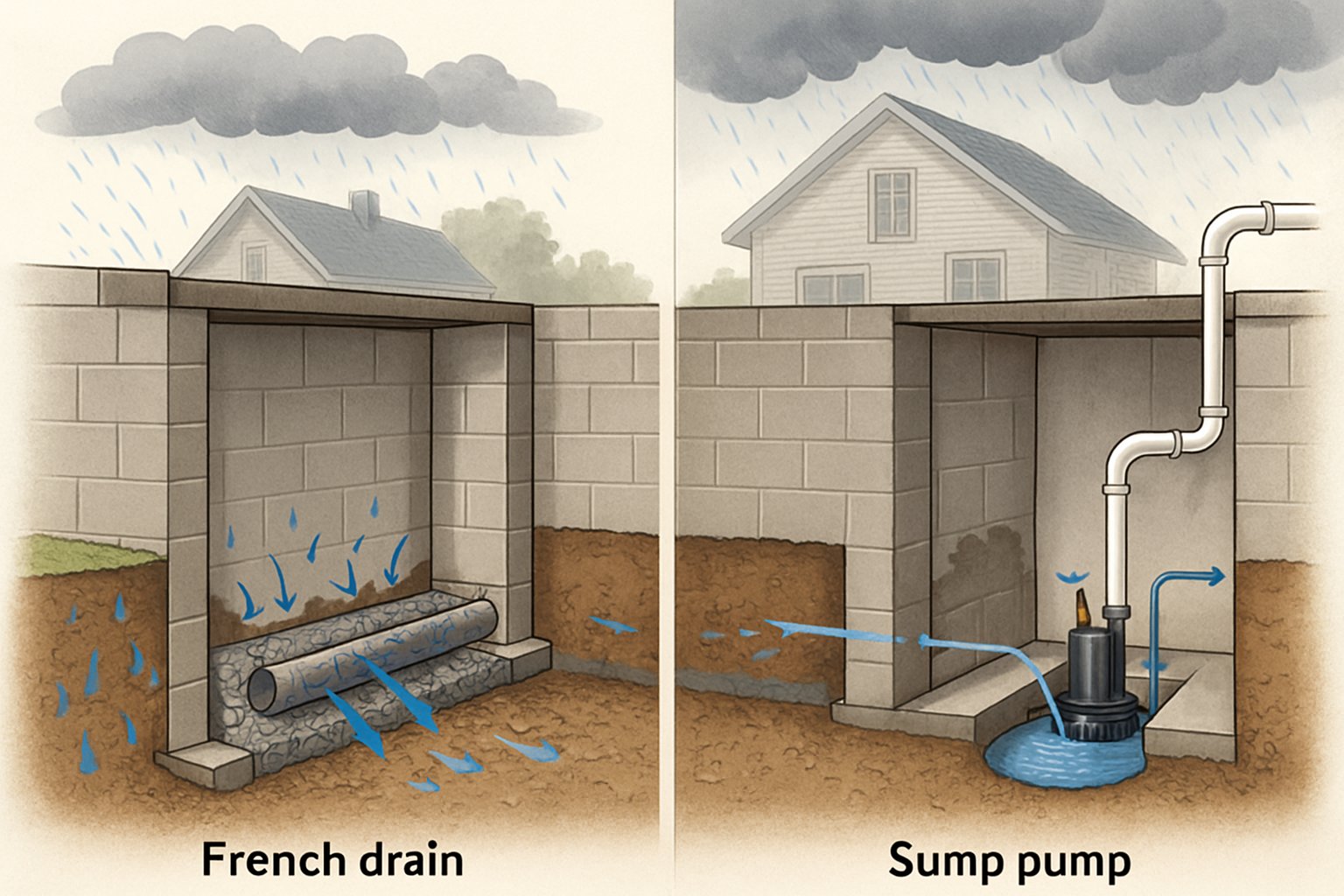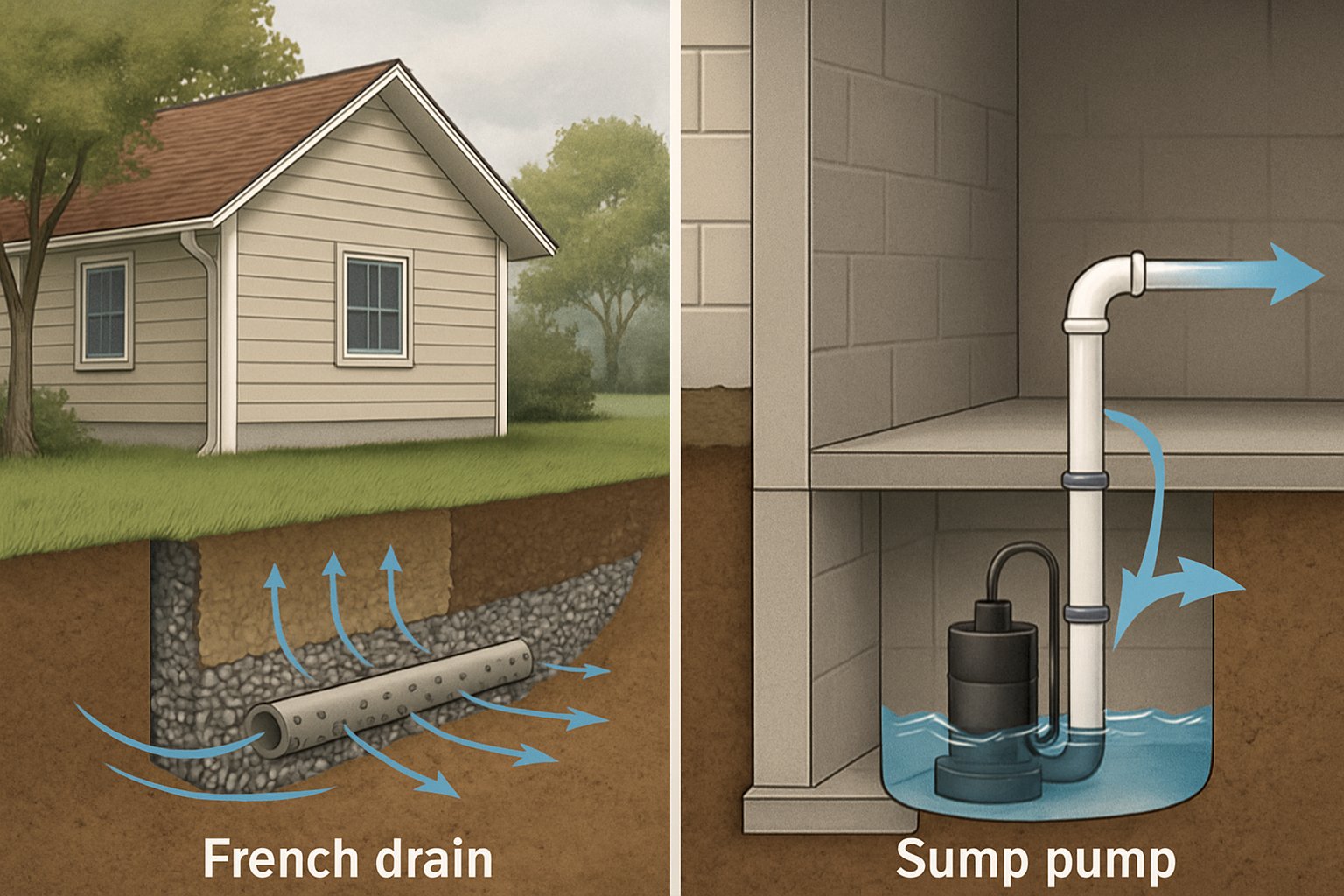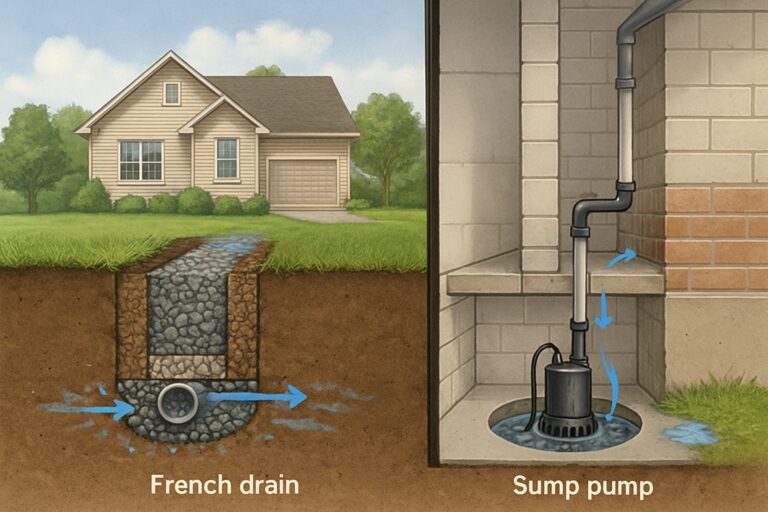Water problems in Missouri basements are a headache thanks to the state’s clay-heavy soil and frequent storms. Lots of homeowners here deal with flooding and have to pick between two main fixes for water issues.

French drains redirect water away from your foundation with underground pipes and gravel. Sump pumps, on the other hand, actively remove water that’s already made it inside your basement.
The best option really depends on your water problem, budget, and how your home is set up. Missouri’s wild weather—heavy rains, stubborn clay soil—makes waterproofing basements a real challenge.
Water tends to pool around foundations here, especially after spring storms. Knowing how each system works will help you make a smarter choice for your place.
Need a Home Fix – Emergency or Routine?
From leaks and no-heat nights to simple tune-ups, our 24/7 hotline connects you with trusted local pros in minutes.
Key Takeaways
- French drains stop water problems by sending water away from your foundation before it gets inside
- Sump pumps kick in to remove water that’s already pooled in your basement
- Your best bet depends on whether you’re fighting surface water or rising groundwater in your part of Missouri
Key Differences Between French Drains and Sump Pumps
French drains and sump pumps tackle water damage in totally different ways. One works on its own without power, while the other relies on mechanical pumps and electricity to get water out.
Passive Versus Active Water Management
French drains are passive systems. They don’t need electricity or moving parts. Gravity does the work, moving water through a perforated pipe surrounded by gravel.
Water just flows away from the foundation, no fancy machinery needed. Sump pumps, though, are active systems that need electrical power to run.
Sensors detect when water rises in a sump pit. The pump flips on and pushes water out through a pipe.
This really matters during storms. French drains keep working even if the power’s out. Sump pumps, unless you have a backup, just stop when the electricity goes off.
How Each System Handles Water Intrusion
French drains keep water from getting into your basement by redirecting it before it hits the foundation. The perforated pipe grabs water from the soil and sends it away from your house.
Sump pumps deal with water that’s already inside. Water comes in through floor drains or cracks, collects in the pit, and the pump sends it out.
French drains run constantly as water moves through the ground. Sump pumps only kick on when water builds up in the basin, so they’re better for sudden floods or big water surges.
Installation Approaches
Installing a French drain means digging trenches around your foundation. Workers lay a perforated pipe in gravel below your basement floor, then connect it to a drainage spot or storm sewer.
Sump pump installation is different. You need a pit in the lowest part of the basement. Water collects there, and the pump gets it out. You’ll need electrical work and a pipe to carry water outside.
French drains take a lot more digging all around the house. Sump pumps just need one spot but do require maintenance and reliable power.
How French Drains Work
French drains use gravity to move water away from your foundation with perforated pipes and gravel. They work passively—no electricity needed—so they’re pretty dependable for managing groundwater in Missouri.
Interior French Drain Systems
Interior French drains go along the basement’s edge where the floor meets the wall. Workers dig a trench inside the basement and fill it with gravel.
A perforated pipe sits at the trench’s bottom, collecting water that seeps through the walls or rises from below. Water travels through the pipe to a collection point, usually a sump basin or floor drain.
The gravel helps filter debris and lets water reach the pipe easily. Interior systems work well in Missouri’s sticky clay soil, catching water after it enters but before it floods the floor.
They’re often cheaper to install than exterior drains, especially in older homes.
Exterior French Drain Applications
Exterior French drains sit outside, down at the footing level. They keep water from ever touching your foundation walls. Workers dig around the house down to the footings, which isn’t a small job.
The drain pipe wraps around the outside of the foundation, surrounded by gravel that stretches up toward ground level. Usually, there’s a waterproof membrane to keep soil out of the system.
Exterior drains are best for new builds. Installing them around existing homes costs way more because of all the digging. Missouri’s freeze-thaw cycles can mess with shallow exterior drains, so depth matters.
The pipe slopes away from the house, letting water exit at a safe spot or into a storm drain.
Role of Perforated and Drainage Pipes
Perforated pipes are the heart of any French drain. They have holes to let water in but keep the flow moving toward the exit. The holes point down to block soil from getting inside.
Pipe materials include:
- PVC with pre-drilled holes
- Corrugated plastic tubing
- Rigid ABS drainage pipe
Drainage pipes need the right slope—about 1% drop per 100 feet—for gravity to do its thing. Missouri’s flat land sometimes means you need longer pipes to get the right angle.
Four-inch pipes work for most homes, but if you expect a lot of water or have a long run, six-inch pipes are better. Pipe connections use couplers (no glue), which helps as the soil shifts with the seasons.
Understanding Sump Pump Systems
A sump pump system has a basin or pit to collect water, a pump to get rid of it, and power options (electric or battery backup). The type of pump you need depends on your water issues and basement layout.
Sump Basin and Sump Pit Functions
The sump basin is where water collects in a sump pump setup. It sits below your basement floor and catches water before it spreads out.
Water gets into the basin through drain tiles or just seeps up from the ground. The basin holds it until it gets high enough to trigger the pump.
There’s a float switch in the basin that senses when water rises. When it hits the right level, the switch turns the pump on.
Key basin components include:
- Concrete or plastic liner
- Drainage pipes feeding into the basin
- Float switch
- Pump housing
Basin size depends on how much water you usually get. Bigger pits handle more water but take up more room under your floor.
Electric and Battery Backup Options
Most sump pumps plug into a regular 115-volt outlet. They run as long as you have power and can keep up during big storms.
If the power goes out, battery backups take over. These use 12-volt marine batteries to keep pumps running during outages.
Power system features:
- Main electric pump for everyday use
- Battery backup for power failures
- Auto-switching between power sources
- Battery charger to keep backup ready
It’s smart to test your backup system now and then. Batteries usually last three to five years before you’ll need to swap them out. Some setups have alarms to let you know if the backup’s running or the battery’s low.
Types of Sump Pumps
Submersible pumps sit right in the pit, working underwater. Their motors stay sealed and quiet. They handle debris better and usually last longer.
Pedestal pumps stand above the pit, with only the intake pipe in the water. The motor stays dry, which makes them cheaper, but they’re noisier and take up more space.
Sewage pumps are for waste water and solid stuff from basement bathrooms. These are heavier-duty and need bigger pipes and motors.
Pump capacity tells you how many gallons per hour it can move. Most homes in Missouri need something that can handle 2,500 to 4,000 gallons an hour during a downpour.
Which pump you pick comes down to your basement’s layout, how much water you get, and whether you need to pump uphill to get water out.
Common Basement Water Issues in Missouri

Basement water problems are a fact of life in Missouri, thanks to heavy rains, clay-rich soil, and high water tables. Homes from Kirkwood to Chesterfield see the same patterns: flooding, seepage, and moisture damage.
Basement Flooding Triggers
Missouri’s wild climate sets the stage for basement flooding. Heavy spring rains and big thunderstorms can dump huge amounts of water fast.
Clay soil doesn’t drain well, so water pools around foundations instead of soaking in. Here’s what usually causes flooding:
- Spring rains that overwhelm drains
- Flash floods from storms
- High groundwater pushing up through floors
- Cracks in foundations letting water in
Some Missouri homes sit on high water tables or above springs, causing year-round moisture headaches. Flood damage often strikes when sump pumps fail during power outages—storms that bring the most water often knock out the power, too.
Water Pooling and Seepage
Water pooling shows up in basement corners, along walls, or low spots. Missouri’s clay keeps water pressed against foundations for days.
Seepage is sneakier. It seeps through concrete walls and floors, especially through tiny cracks or where the wall meets the floor.
Common seepage spots:
- Where walls meet floors
- Around utility pipes
- Hairline cracks in the concrete
- Spots where the foundation settled
You might spot wet patches after rain that dry slowly. That’s a sign of ongoing seepage you shouldn’t ignore.
Chronic pooling creates efflorescence—those white mineral stains on basement walls. It’s a sure sign water keeps moving through your concrete.
Mold Growth Risks
Missouri’s humid climate, mixed with basement moisture, sets the stage for mold. When temperatures sit between 60-80 degrees and humidity climbs past 60%, mold spores start multiplying fast.
Mold often shows up within a day or two after flooding or water damage. If you spot dark patches, smell a musty odor, or see fuzzy growth on your walls, that’s a clear sign of mold.
High-risk areas for mold include:
- Behind water heaters and furnaces
- In carpet padding after flooding
- Along basement walls with seepage
- Around windows and door frames
Things like wood, drywall, and carpet give mold plenty to feed on. Once it gets a foothold, mold spreads all over the basement pretty quickly.
Breathing in basement mold can lead to respiratory issues, allergies, or asthma flare-ups. Kids and older adults seem to have it the worst when it comes to mold exposure.
Once mold growth covers more than 10 square feet or keeps coming back after cleaning, it’s time to call in the pros.
Comparative Benefits and Drawbacks

French drains and sump pumps both help with basement water problems, but they work differently. If you’re in Missouri, knowing these differences can help you pick the right system for your home.
Water Removal Efficiency
French drains use gravity to move water. They pull water along their length and send it away from your foundation—no electricity needed.
This passive approach works well for light or moderate water issues. French drains are great at stopping water before it becomes a headache.
Sump pumps, on the other hand, kick in when things get serious. They can pump out hundreds of gallons per hour if water levels trip their sensors.
Key efficiency differences:
- French drains: Continuous, passive drainage
- Sump pumps: High-volume, active pumping
- French drains: Better for surface water management
- Sump pumps: Superior for groundwater and flooding
During a power outage, sump pumps stop unless you have a battery backup. French drains just keep doing their thing, no matter what.
Cost and Maintenance Considerations
French drains need occasional cleaning and a quick check for clogs. Most folks spend less on maintenance with these than with anything mechanical.
But the upfront cost for French drains can sting—especially if you install them around your foundation. All that digging and material adds up fast.
Sump pump maintenance means testing the motor, float switch, and pipes regularly. You’ll probably have to replace the pump every 7 to 10 years.
Installing a sump pump usually costs less at first, but maintenance and replacements sneak up on you over the years. Add a backup system and the price keeps climbing.
Since French drains have barely any moving parts, they don’t break down much. If you ever need to replace the whole system, though, it’s a big job.
Long-Term Durability
French drains can last 15 to 25 years if you install and maintain them right. Using good materials and making sure the slope is correct really helps.
Clogs from dirt or roots cause most of the trouble. Flushing the system now and then keeps it running.
Sump pumps last anywhere from 7 to 12 years, depending on how often they run and the water conditions. If your pump kicks on a lot during storms, the motor wears out faster.
Durability factors:
- French drains: Longer lifespan, fewer moving parts
- Sump pumps: Shorter replacement cycles, motor wear
- French drains: Susceptible to clogging over time
- Sump pumps: Vulnerable to mechanical failures
Missouri’s clay soil can be tough on both systems. French drains clog up more, while sump pumps work harder because the soil doesn’t drain well.
Choosing the Right Solution for Missouri Homes
Missouri homeowners really need solid water management to keep their homes safe from flooding and moisture. Picking between a French drain and a sump pump depends on your water issues, soil, and even your home’s layout.
When to Use a French Drain
French drains shine in Missouri homes with steady groundwater problems and soil that drains well. If you’ve got sandy or loose soil, water moves away easily with this system.
If you always see water pooling near your foundation, a French drain might be the answer. It pulls groundwater away before it sneaks into your basement.
French drains tackle these Missouri headaches:
- Water gathering around foundation walls
- Yards that stay soggy forever
- Basement dampness from groundwater seepage
- Foundation settling from too much water
They’re especially good for homes on hills, where gravity gives you a hand. You won’t have to fuss with them as much as you would with pumps, plus they don’t need power.
When to Install a Sump Pump
Sump pumps make more sense if you live where clay soil traps water or drainage is poor. They actively remove any water that collects in the basement.
Missouri’s clay soil just holds onto water. A sump pump takes care of it by pumping the water out, no matter how stubborn the soil is.
It’s time for a sump pump if you notice:
- Water pooling in basement corners
- Flooding when storms hit hard
- High water table close to your foundation
- Bad drainage around the house
Sump pumps keep basements dry by collecting water in a pit and pumping it away. They’re fast during storms, but you’ll need power and to keep up with maintenance.
Combining Both Systems for Maximum Protection
Honestly, a lot of Missouri homes end up with both a French drain and a sump pump. This combo gives you full water management for all kinds of flooding.
The French drain deals with normal groundwater and light moisture. When things get wild, the sump pump jumps in and handles the extra water.
Benefits of combined systems:
- French drain takes some pressure off the sump pump
- You’ve got backup if one system fails
- Whole-basement waterproofing
- Handles Missouri’s unpredictable weather better
Sure, it’s a bigger investment, but it covers you from all angles. The French drain works quietly in the background, and the sump pump only turns on when you really need it.
Frequently Asked Questions
Missouri’s mix of clay-heavy soil and wild weather keeps homeowners on their toes when it comes to water. Knowing the differences, costs, and what it takes to keep these systems running can save you a lot of headaches.
What are the main differences between a French drain and a sump pump in terms of water management for homes in Missouri?
A French drain uses gravity to collect water and send it away from your foundation with perforated pipes and gravel. It keeps working without electricity, moving groundwater before it creeps inside.
A sump pump kicks in only when water collects in a pit. It uses electricity to pump water out through pipes once the pit fills up enough to trigger the system.
So, French drains prevent water issues by stopping water at the source. Sump pumps fix the problem after water’s already in your basement.
How does the soil composition in Missouri affect the efficiency of a French drain compared to a sump pump?
Missouri’s clay soil just doesn’t let water drain well, which hurts French drain performance. Water can back up around the foundation because it can’t move through the dense soil fast enough.
During wet spells, heavy clay pushes against basement walls and can overwhelm a French drain. Gravity just can’t keep up sometimes.
Sump pumps don’t care about slow-draining soil—they just pump the water out, no matter what the ground’s like outside.
In what situations is it more appropriate to install a French drain over a sump pump for a Missouri property?
If your property drains well and only has minor water issues, go with a French drain. Homes on hills or higher ground, where gravity helps, really benefit from this setup.
Building a new house? That’s the perfect time to put in a French drain since it’s way easier and cheaper than digging up your yard later.
If you can’t count on electricity, stick with a French drain. Folks in rural Missouri with frequent outages tend to prefer gravity-based systems.
What maintenance considerations should Missouri homeowners keep in mind when choosing between a French drain and a sump pump?
French drains need you to clear out debris and sediment every so often. Sometimes roots sneak into the pipes, which means calling in a pro or replacing a section.
Sump pumps need you to test them regularly. Check the pump every month, and swap out backup batteries every year if you have them.
After a big storm, look over both systems. Missouri weather can overwhelm or damage either one in a hurry.
Can a French drain and sump pump system be integrated, and how would this benefit Missouri homeowners dealing with water drainage issues?
You can tie a French drain right into a sump pump pit. The drain channels water in, and when gravity can’t keep up, the pump takes over.
This setup works well with Missouri’s tough soil. The French drain handles the daily stuff, while the sump pump kicks in during heavy rains or when clay slows everything down.
If one system fails, the other keeps working. With both, you get steady drainage plus a backup plan for those really wet days.
What are the legal or building code implications in Missouri for installing a French drain or a sump pump?
Missouri building codes say you need permits for most drainage system installs. If you want to put in a French drain or a sump pump that discharges water, you have to get a permit first.
You can’t just let discharge water run onto your neighbor’s yard or into public spaces. Local municipalities decide exactly where you can release the water from your drainage system.
If you’re installing a sump pump, you’ll need to follow electrical codes too. A licensed electrician should handle the wiring to meet Missouri’s safety rules.







Leave a Reply